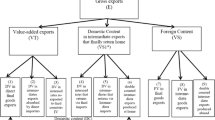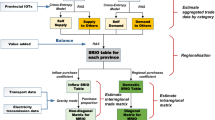Abstract
The article considers the use of the input–output scheme of the Japanese economy for the system analysis and modeling of the multi-sectoral economy of Japan (the input–output table in producers’ prices, 37 aggregated industries, 2015). An aggregated 107-industry input–output table of the Japanese economy has been compiled into 37 major industries. Based on this model, a system analysis and modeling of inter-industry linkages in the Japan’s economy are performed according to the traditionally used procedures for analyzing and modeling inter-sectoral linkages. Value-added coefficients, imports, inducement, and output are analyzed. Industries are classified by their cost (key industries, industries with direct impact, industries with reverse impact, etc.). The sectoral structure of GDP is determined. Conclusions on the possibility of using these methods of analysis and modeling regarding the economy of Ukraine and the prospects for further research have been prepared.
Similar content being viewed by others
References
1990 Input–Output Tables for Japan: Summary in English, Management and Coordination Agency, Japan (1995). URL: https://www.soumu.go.jp/main_content/000449911.pdf.
2015 Input–Output Tables for Japan, Ministry of Internal Affairs and Communications, Japan (2021) URL: https://www.soumu.go.jp/main_content/000732915.pdf.
2015 Input–Output Tables for Japan, Ministry of Internal Affairs and Communications, Japan, e-Stat (portal site for Japanese Government Statistics). URL: https://www.soumu.go.jp/english/dgpp_ss/data/io/io15_00001.htm.
M. Kuboniwa, S. Tabata, M. Tabata, and Y. Hasebe, Mathematical Economics on the Personal Computer [Russian translation], Finansy i Statistika, Moscow (1991).
A. Rose and W. Miernyk, “Input–output analysis: The first fifty years,” Econ. Syst. Res., Vol. 1, Iss. 2, 229–272 (1989). https://doi.org/10.1080/09535318900000016.
E. Dietzenbacher, M. Lenzen, B. Los, D. Guan, M. L. Lahr, F. Sancho, S. Suh, and C. Yang, “Input–output analysis: The next 25 years,” Econ. Syst. Res., Vol. 25, Iss. 4, 369–389 (2013). https://doi.org/10.1080/09535314.2013.846902.
W. W. Leontief, “Quantitative input and output relations in the economic systems of the United States,” The Review of Economic Statistics, Vol. 18, No. 3, 105–125 (1936). https://doi.org/https://doi.org/10.2307/1927837.
W. Leontief, Input-Output Economics, 2nd ed., Oxford University Press, New York–Oxford (1986).
W. W. Leontief, “Foreword to the Journal of the International Input–Output Association,” Econ. Syst. Res., Vol. 1, Iss. 1, 3–4 (1989). https://doi.org/10.1080/09535318900000001.
Suh S. (ed.), Handbook of Input–Output Economics in Industrial Ecology; Eco-Efficiency in Industry and Science, Vol. 23, Springer, Dordrecht (2009). https://doi.org/10.1007/978-1-4020-5737-3.
N. Agatsuma, A. Nakamura, and Y. Nakamura, “Structure of the Japanese economy in the year 2000,” Econ. Syst. Res., Vol. 1, Iss. 1, 69–86 (1989). https://doi.org/10.1080/09535318900000006.
J. M. Gowdy, “Structural change in the USA and Japan: An extended input–output analysis,” Econ. Syst. Res., Vol. 3, Iss. 4, 413–424 (1991). https://doi.org/10.1080/09535319100000030.
K. Fujikawa, H. Izumi, and C. Milana, “Multilateral comparison of cost structures in the input–output tables of Japan, the US and West Germany,” Econ. Syst. Res., Vol. 7, Iss. 3, 321–342 (1995). https://doi.org/10.1080/09535319500000027.
S. Nakano, S. Arai, and A. Washizu, “Economic impacts of Japan’s renewable energy sector and the feed-in tariff system: Using an input–output table to analyze a next-generation energy system,” Environ. Econ. Policy Stud., Vol. 19, Iss. 3, 555–580 (2017). https://doi.org/10.1007/s10018-016-0158-1.
S. Nakano and A. Washizu, “Creation and application of the 2015 input–output table for analysis of next-generation energy systems: Analysis of the effects of introducing carbon tax,” RIEEM Discussion Paper Series 2103, Research Institute for Environmental Economics and Management, Waseda University (2022). URL: http://www.waseda.jp/prj-rieem/dp/dp2103.pdf.
H. Kohno and Y. Higano, Public Investment Criteria: Using an Interregional Input-Output Programming Model, Springer, New York (2022). https://doi.org/https://doi.org/10.1007/978-4431-55221-5.
S. Mahajan et al. (eds.), Handbook on Supply and Use Tables and Input-Output Tables with Extensions and Applications, United Nations, New York (2018).
I. Remond-Tiedrez and J. M. Rueda-Cantuche (eds.), EU Inter-Country Supply, Use and Input–Output Tables — Full International and Global Accounts for Research in Input–Output Analysis (FIGARO), Publications Office of the European Union, Luxembourg (2019).
U. Temursho, M. A. Cardenete, K. Wojtowicz, L. Rey Los Santos, M. Weitze, T. Vandyck, and B. Saveyn, Projecting Input–Output Tables for Model Baselines, EUR 30216 EN, Publications Office of the European Union, Luxembourg (2020). https://doi.org/10.2760/5343.
Input–Output Tables for Japan, Ministry of Internal Affairs and Communications, Japan. URL: https://www.soumu.go.jp/english/dgpp_ss/data/io/index.htm.
V. Kulyk, “Analysis of Japan’s and Ukraine’s sectoral structure of the economy within the framework of the aggregated input–output models,” RFI Scientific Papers, No. 3(92), 109–127 (2020). https://doi.org/10.33763/npndfi2020.03.109.
European System of Accounts — ESA 2010, Publications Office of the European Union, Luxembourg (2013). https://doi.org/10.2785/16644.
V. Kulyk, “Japan experience: System analysis and modelling inter-industry relations,” Finance of Ukraine, No. 1, 83–102 (2021). https://doi.org/10.33763/finukr2021.01.083.
O. I. Yastremskii, “Key and effective economic activities of Ukraine,” Ukrainian Economic Science Herald, No. 2, 177–182 (2018). URL: http://nbuv.gov.ua/UJRN/Venu_2018_2_33.
O. Yastremskii, “Input–output productivity cost analysis of the economy of Ukraine: Selected cross-countries and intertemporal comparison,” Cybern. Syst. Analysis, Vol. 56, No. 4, 591–602 (2020). https://doi.org/https://doi.org/10.1007/s10559-020-00276-z.
H. Nikaido, “Convex structures and economic theory,” in: R. Bellman (ed.), Ser. Mathematics in Science and Engineering, Vol. 51, Academic Press, New York (1968).
V. M. Glushkov, “DISPLAN: A new planning technology,” Uprav. Sistemy i Mashiny, No. 6, 5–11 (1980).
P. N. Rasmussen, Studies in Inter-Sectoral Relations, North-Holland, Amsterdam (1956).
N. H. P. Ha and B. Trinh, “Vietnam economic structure change based on Vietnam input-output tables 2012 and 2016,” Theor. Econ. Lett., Vol. 8, No. 4, 699–708 (2018). https://doi.org/https://doi.org/10.4236/tel.2018.84047.
H. Gurgul and L. Lach, “Key sectors after a decade of transition: Evidence from Poland,” Managerial Economics, Vol. 16, No. 1, 39–76 (2015). http://dx.doi.org/https://doi.org/10.7494/manage.2015.16.1.39
Author information
Authors and Affiliations
Corresponding author
Additional information
Translated from Kibernetyka ta Systemnyi Analiz, No. 2, March–April, 2023, pp. 72–86
Rights and permissions
Springer Nature or its licensor (e.g. a society or other partner) holds exclusive rights to this article under a publishing agreement with the author(s) or other rightsholder(s); author self-archiving of the accepted manuscript version of this article is solely governed by the terms of such publishing agreement and applicable law.
About this article
Cite this article
Gasanov, S.S., Kulyk, A.V. & Kulyk, V.V. Systems Analysis and Modeling a Multi-Sectoral Economy Based on the Input–Output Model (An Example of Japanese Economy). Cybern Syst Anal 59, 238–250 (2023). https://doi.org/10.1007/s10559-023-00558-2
Received:
Published:
Issue Date:
DOI: https://doi.org/10.1007/s10559-023-00558-2




